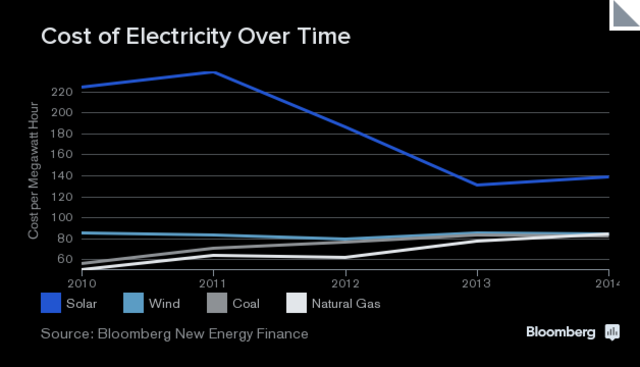forum
library
tutorial
contact

U.S. Wind Power Blows
New Records. Again. And Again.
by Tom Randall
Bloomberg News, April 7, 2014
|
the film forum library tutorial contact |

|
U.S. Wind Power Blows
by Tom Randall
|
 Wind was responsible for 4.8 percent of America's electricity used in January. That's the highest January total ever, breaking the record from last January, which broke the record for the January before that, and so on. The chart below shows the latest data from the U.S. Energy Information Association.
Wind was responsible for 4.8 percent of America's electricity used in January. That's the highest January total ever, breaking the record from last January, which broke the record for the January before that, and so on. The chart below shows the latest data from the U.S. Energy Information Association.
America's rising wind power feels unstoppable. That's because in many areas of the country wind has reached an important tipping point: becoming cheaper than coal and natural gas. In fact, states getting the most electricity from wind include gas-rich Texas, Oklahoma and Colorado.
Onshore wind power has come of age, and not just in the U.S. This next chart shows the levelized cost of energy worldwide, using data from Bloomberg New Energy Finance (BNEF). Average onshore wind power now costs the same as gas worldwide, at about $84 per megawatt hour. That's without subsidies.
In the U.S., competition between wind and gas is fierce. New techniques known as fracking (or hydraulic fracturing for the timid) have overhauled the U.S. energy economy and brought America some of the cheapest natural gas prices in the world. In order to compete, U.S. wind relied on a tax credit, which expired at the end of last year.
Even without the subsidy, wind prices are getting cheaper as the technology improves. The cost of wind energy has declined by 43 percent over the last four years. There's a backlog of projects that already qualified for the tax credit that will ensure a steady pace of turbine growth for the next few years, according to BNEF wind analyst Amy Grace.
The future of the wind tax credit is contentious and uncertain, but so is America's cheap gas prices. As expensive coal plants are retired, utilities are switching to cheaper natural gas, driving up the price, says Grace. Also, the U.S. Energy Department is opening up domestic gas for exports for the first time. By 2020, U.S. shale gas may account for 20 percent of the global market, according to a Citigroup estimate.
If Americans have to buy gas anywhere near international market prices, wind wins. Gas may be booming, but you can expect many more wind records to come.
learn more on topics covered in the film
see the video
read the script
learn the songs
discussion forum
